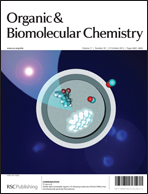Diastereotopic group selectivity and chemoselectivity of alkylidene carbene reactions on 8-oxabicyclo[3.2.1]oct-6-ene ring systems†
Abstract
α-Hydroxyalkylidene carbenes, generated from thermolysis of α,β-epoxy-N-aziridinylimines, undergo diastereotopic group selective 1,5 C–H insertion reactions on 2,4-dimethyl-8-oxabicyclo[3.2.1]oct-6-ene ring systems. Protection of a tertiary alcohol at C-3 of the bridged oxabicycle as a trimethylsilyl ether reverses the sense of diastereoselectivity. 1,5 C–H insertion into a methine adjacent to an OBn group, 1,5 O–R insertion into a tertiary alcohol (R = H) or silylether (R = TMS) at C-3 to form spirocyclic dihydrofurans, 1,2-rearrangement to an alkyne and fragmentation to a ketone are competing major pathways for 2-benzyloxy-substituted 8-oxabicyclo[3.2.1]oct-6-ene systems. Dihydrofuran formation is shown to be a result of substitution on the oxabicyclic ring system through comparison with other methods of alkylidene carbene formation.
![Graphical abstract: Diastereotopic group selectivity and chemoselectivity of alkylidene carbene reactions on 8-oxabicyclo[3.2.1]oct-6-ene ring systems](/en/Image/Get?imageInfo.ImageType=GA&imageInfo.ImageIdentifier.ManuscriptID=C3OB41390J&imageInfo.ImageIdentifier.Year=2013)

 Please wait while we load your content...
Please wait while we load your content...